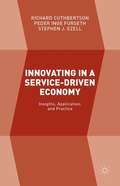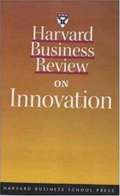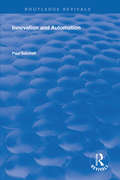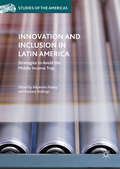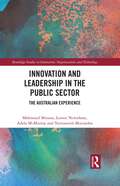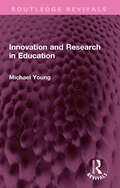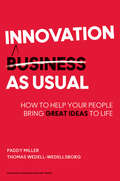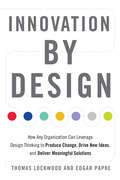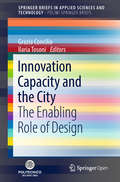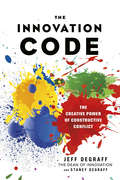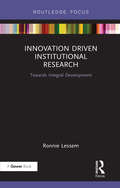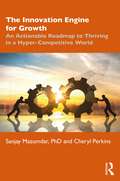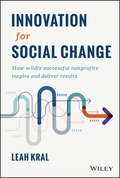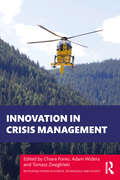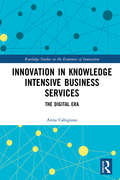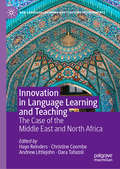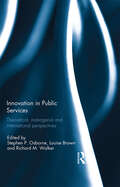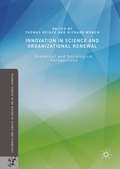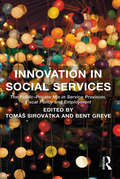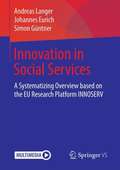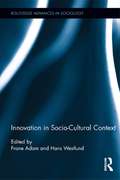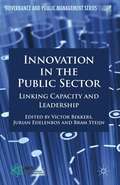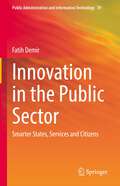- Table View
- List View
Innovating in a Service-Driven Economy: Insights, Application, and Practice
by Richard Cuthbertson Peder Inge Furseth Stephen J. EzellInnovating in a Service-Driven Economy.
Innovation and Automation (Routledge Revivals)
by Paul SatchellFirst published in 1998, this book links the forces of innovation and automation positively by shifting the focus on human-machine interactions from the current, technology-centred approach, to one where sharing is evolved and creativity is no longer suppressed. It provides a unique way of understanding innovation in organisations, by using an environmental interaction approach to understand creativity and its translation into innovatory behaviour. The current dampening of creativity in organisations is made meaningful by explaining organisational behaviour in terms of rituals. The author succinctly assembles the current evidence that the prevailing technology-centred approach to automation is in part responsible for the inability of humans to be creative in work situations. Many of the behavioural constraints necessary for this type of automation paralyse the translation of creativity into innovatory behaviour. In producing an antidote to the technology-centred approach, he moves beyond current human-centred thinking, to an approach where humans and machines share by using the same processes that underlie the sharing between humans. This sharing-centred approach to automation is explained and illustrated. Throughout the book the current state of human-machine interactions is illustrated with vignettes from aviation, medicine and from organisations. The book also discusses three pictures of future human-machine interactions of the flightdeck, in primary care medical practice, and in boardrooms of major organisations. The main readership includes all who are interested in innovation and organisational development, especially in the technology based industries and services such as healthcare, transportation, manufacturing and information systems; it provides essential new ideas for senior executives, strategic consultants, specialists in organisational behaviour and human resources, members of regulatory agencies and other government facilities, and academicians and researchers.
Innovation and Inclusion in Latin America
by Alejandro Foxley Barbara StallingsThis book argues that Latin America must confront two main challenges: greater innovation to increase productivity, and greater inclusion to incorporate more of the population into the benefits of economic growth. These two tasks are interrelated, and both require greater institutional capacity to facilitate both innovation and inclusion. Most countries in Latin America are struggling to escape what economists label "the middle income trap. " While much if not all of the region has emerged from low income status, neither growth nor productivity has increased sufficiently to enable Latin America to narrow the gap separating it from the world's most developed economies. Although income inequality has diminished across much of the region in recent years, social vulnerability remains widespread and institutional weaknesses continue to plague efforts to achieve equitable development. This volume identifies lessons that can be learned and adapted from experiences within the region and in East Asia, where the middle income trap has largely been avoided. This book is the result of a collaborative project undertaken by American University's Center for Latin American & Latino Studies (CLALS) and the Corporation for Latin American Studies (CIEPLAN) in Chile, with financial support from the Inter-American Development Bank's Office of Strategic Planning and Development Effectiveness.
Innovation and Leadership in the Public Sector: The Australian Experience (Routledge Studies in Innovation, Organizations and Technology)
by Mahmoud Moussa Leonie Newnham Adela McMurray Nuttawuth MuenjohnUsing empirical data, this book uniquely presents the dynamics of innovation within public sector organisations and identifies the most crucial factors that promote innovation or the determinants that enhance innovation activities. It presents a macro and micro analysis of workplace innovation in the Australian public sector written by a combination of practitioners and academics to provide both theoretical and practical insights. The book reviews the relationship between culture and workplace innovation as a multi-dimensional, subjective and context specific phenomenon operating dynamically as organisational innovation, organisational climate for innovation, team and individual innovation. It identifies a variance in the perception of workplace innovation and organisational culture between public sector employees with different demographic and employment characteristics. The demographic and employment characteristics confirm that employees in a Public Sector Department of State exhibit significant differences between various groups in how culture impacts on workplace innovation. This knowledge assists practitioners in developing positive cultural environments that support the development of workplace innovation and raise awareness in considering the differences within organisations caused by an individual’s characteristics. Lastly, the book reviews public organisations around the world and provides a cross cultural comparison of public sector innovation and leadership. This includes a review of the major forms of public sector systems in operation and how this relates to innovation and leadership. Innovation and Leadership in the Public Sector is written for academics and students interested in the public sector innovation field. It’s suitable for both graduate and undergraduate students and researchers in the fields of public administration, management policy, organisational behaviour, human resources management (HRM) and human resources development (HRD) courses. Additionally, this book is suitable for middle-to-senior-level administrators or managers who wish to develop more innovative public sector organisations.
Innovation and Leadership in the Public Sector: The Australian Experience (Routledge Studies in Innovation, Organizations and Technology)
by Mahmoud Moussa Leonie Newnham Adela McMurray Nuttawuth MuenjohnUsing empirical data, this book uniquely presents the dynamics of innovation within public sector organisations and identifies the most crucial factors that promote innovation or the determinants that enhance innovation activities. It presents a macro and micro analysis of workplace innovation in the Australian public sector written by a combination of practitioners and academics to provide both theoretical and practical insights.The book reviews the relationship between culture and workplace innovation as a multi-dimensional, subjective and context-specific phenomenon operating dynamically as organisational innovation, organisational climate for innovation, team and individual innovation. It identifies a variance in the perception of workplace innovation and organisational culture between public sector employees with different demographic and employment characteristics. The demographic and employment characteristics confirm that employees in a Public Sector Department of State exhibit significant differences between various groups in how culture impacts on workplace innovation. This knowledge assists practitioners in developing positive cultural environments that support the development of workplace innovation and raise awareness in considering the differences within organisations caused by an individual’s characteristics. Lastly, the book reviews public organisations around the world and provides a cross cultural comparison of public sector innovation and leadership. This includes a review of the major forms of public sector systems in operation and how this relates to innovation and leadership.Innovation and Leadership in the Public Sector is written for academics and students interested in the public sector innovation field. It’s suitable for both graduate and undergraduate students and researchers in the fields of public administration, management policy, organisational behaviour, human resources management (HRM) and human resources development (HRD) courses. Additionally, this book is suitable for middle-to-senior-level administrators or managers who wish to develop more innovative public sector organisations.
Innovation and Research in Education (Routledge Revivals)
by Michael YoungOriginally published in 1965, this title looks at programmed learning, language laboratories, curricular reform, educational television, team teaching – these are just some of the fashions that were going to change education in the following decade quite as much as the introduction of comprehensive schools. Would anyone ever know what their effects are? Not unless there was a great expansion of research. The author of this book states the need for a marriage of innovation and research. The social sciences could gain as much as education. Today it can be read in its historical context.
Innovation as Usual
by Paddy Miller Thomas Wedell-WedellsborgTurn team members into innovatorsMost organizations approach innovation as if it were a sideline activity. Every so often employees are sent to "Brainstorm Island": an off-site replete with trendy lectures, creative workshops, and overenthusiastic facilitators. But once they return, it's back to business as usual.Innovation experts Paddy Miller and Thomas Wedell-Wedellsborg suggest a better approach. They recommend that leaders at all levels become "innovation architects," creating an ecosystem in which people engage in key innovation behaviors as part of their daily work.In short, this book is about getting to a state of "innovation as usual," where regular employees-in jobs like finance, marketing, sales, or operations-make innovation happen in a way that's both systemic and sustainable.Instead of organizing brainstorming sessions, idea jams, and off-sites that rarely result in success, leaders should guide their people in what the authors call the "5 + 1 keystone behaviors" of innovation: focus, connect, tweak, select, stealthstorm, (and the + 1) persist: Focus beats freedom: Direct people to look only for ideas that matter to the business Insight comes from the outside: Urge people to connect to new worlds First ideas are flawed: Challenge people to tweak and reframe their initial ideas Most ideas are bad ideas: Guide people to select the best ideas and discard the rest Stealthstorming rules: Help people navigate the politics of innovation Creativity is a choice: Motivate everyone to persist in the five keystone behaviorsUsing examples from a wide range of companies such as Pfizer, Index Ventures, Lonza, Go Travel, Prehype, DSM, and others, Innovation as Usual lights the way toward embedding creativity in the DNA of the workplace.So cancel that off-site. Instead, read Innovation as Usual-and put innovation at the core of your business.
Innovation by Design: How Any Organization Can Leverage Design Thinking to Produce Change, Drive New Ideas, and Deliver Meaningful Solutions
by Thomas Lockwood Edgar PapkeWhy are some organizations more innovative than others? How can we tap into, empower, and leverage the natural innovation within our organizations that is so vital to our future success?Now more than ever, companies and institutions of all types and sizes are determined to create more innovative organizations. In study after study, leaders say that fostering innovation and the need for transformational change are among their top priorities. But they also report struggling with how to engage their cultures to implement the changes necessary to maximize their innovative targets.In Innovation by Design, authors Thomas Lockwood and Edgar Papke share the results of their study of some of the world&’s most innovative organizations, including:The 10 attributes leaders can use to create and develop effective cultures of innovation.How to use design thinking as a powerful method to drive employee creativity and innovation.How to leverage the natural influence of the collective imagination to produce the &“pull effect&” of creativity and risk taking.How leaders can take the &“Fifth Step of Design&” and create their ideal culture.Innovation by Design offers a powerful set of insights and practical solutions to the most important challenge for today&’s businesses—the need for relevant innovation.
Innovation Capacity and the City: The Enabling Role of Design (SpringerBriefs in Applied Sciences and Technology)
by Grazia Concilio Ilaria TosoniThis open access book represents one of the key milestones of DESIGNSCAPES, an H2020 CSA (Coordination and Support Action) research project funded by the European Commission under the Call “User-driven innovation: value creation through design-enabled innovation”. The book demonstrates that adopting design allows us to embed innovation within the city so as to arrive at feasible answers to complex global challenges. In this way, innovation can become disruptive, while also sparking a dynamic of gradual change in the “urbanscape” it acts within. To explore this potential, the book puts forward the concept of “design enabled innovation in urban environments” and examines the part that the city can play in promoting and facilitating the adoption of design among public and private sector innovators. This leads to a potential evaluation framework in which a given urbanscape is assessed both in terms of its capacity for generating innovation, and of the nature (more or less design-dependent or design-prone) of the innovative initiatives it hosts. This thread of reasoning holds many promising implications, including a possible “third way” between those who dream of an alternative economic model where revenues and growth are sacrificed on the altar of social and environmental respect, and the supporters of the traditional market-based view, who feel it is enough to add a touch of responsibility and concern to a system that should continue rewarding the profitability of innovations.
The Innovation Code: The Creative Power of Constructive Conflict
by Jeff Degraff Staney DegraffThe Innovation CodeThe Creative Power of Constructive ConflictHarmony is sublime in music but deadly to innovation. The only way to create new, hybrid solutions is to clash. Innovation happens when we bring people with contrasting perspectives and complementary areas of expertise together in one room. We innovate best with people who challenge us, not people who agree with us. It sounds like a recipe for chaos and confusion. But in The Innovation Code, Jeff DeGraff, dubbed the “Dean of Innovation,” and Staney DeGraff introduce a simple framework to explain the ways different kinds of thinkers and leaders can create constructive conflict in any organization. This positive tension produces ingenious solutions that go far beyond “the best of both worlds.” Drawing on their work with nearly half of the Fortune 500 companies, the DeGraffs help you harness the creative energy that arises from opposing viewpoints. They identify four contrasting styles of innovator—the Artist, the Engineer, the Athlete, and the Sage—and include exercises and assessments for building, managing, and embracing the dynamic discord of a team that contains all four. You can also figure out where you fit on the continuum of innovator archetypes. Using vivid examples, The Innovation Code offers four steps to normalize conflict and channel it to develop something completely new. By following these simple steps, you will get breakthrough innovations that are both good for you and your customers. This is a rigorous but highly accessible guide for achieving breakthrough solutions by utilizing the full—and seemingly contradictory—spectrum of innovative thinking.
Innovation Driven Institutional Research: Towards Integral Development (Transformation and Innovation)
by Ronnie LessemThis is the third volume in the CARE-ing for Integral Development series. It continues to build on the previous two works, Community Activation and Awakening Integral Consciousness, as well as preceding the fourth and final book, Embodying Integral Development. This book serves as a follow-up to the author's approach to integral research and development, economics and enterprise, contained within the Innovation and Transformation series, and as a focus for how put all of this "CARE-fully" to work. This third volume, in the CAREquartet is perhaps the most crucial one, building on the organizational systems (see Awakening Integral Consciousness) that came before and turning from trans-cultural and transformational to trans-disciplinary, from integral reality and integral rhythm to integral realms, with a view ultimately to transpersonal, integral rounds. The author turns his attention to research and innovation, and then focuses in on enterprise and economics, management and leadership. As such, he introduces his Inter-Institutional Genealogyin place of an "integral", yet still inhibiting, university. In the process this book paves the way for a new kind of institutionalized, innovation driven social research, which, while rooted in a particular place, speaks to the world as a whole. Moreover, such a research-and-innovation institution has a fundamental role to play in the evolution of a specific community, building on what has come CARE-wise before.
The Innovation Engine for Growth: An Actionable Roadmap to Thriving in a Hyper-Competitive World
by Sanjay Mazumdar Cheryl PerkinsWritten by experts on innovation and growth, this book provides the necessary tools to systematically develop and sustain profitable innovation pipelines. In a hypercompetitive global market, businesses must innovate to survive; yet the failure rate for innovation is extremely high. Strategists and thought leaders, Cheryl Perkins and Dr. Sanjay Mazumdar, offer a sophisticated yet practical approach for implementing successful innovation. Leveraging thought-provoking questions and powerful templates, the book outlines how companies can leverage core strengths, build internal innovation capabilities, partner effectively, and identify the promising areas to pursue. In addition, the book highlights emerging innovations in several major industries, providing fodder to fuel creative thinking and exploration of possible applications across a variety of different industries. Managers and leaders will welcome the innovation insights and examples, as well as the templates to build an organization’s plan to diagnose patterns of innovation, identify opportunities, and apply emerging innovations in their own industries and businesses.
Innovation for Social Change: How Wildly Successful Nonprofits Inspire and Deliver Results
by Leah KralTransform your nonprofit&’s ability to innovate for the future In Innovation for Social Change, distinguished author Leah Kral delivers a practical manual for nonprofits and charitable organizations seeking to innovate their way toward new and exciting possibilities. In the book, you&’ll explore hands-on design thinking strategies and techniques you can use as a disciplined process for exploring what&’s possible in your organization. You&’ll learn how to identify hidden needs, deal with the knock-on effects of your ideas, and focus your efforts where they can have the most impact. You&’ll also discover how to transform your ideas into action, building small experiments and learning from them before scaling them up organization-wide, and how to create an ecosystem for everyday innovation. Finally, the author explains what we can learn from social entrepreneurs as they boldly challenge the status quo. The book also includes: Six basic and mutually reinforcing principles that will help you become more innovative today Instructive and engaging case studies from nonprofits with a variety of missions, visions, and political backgrounds Strategies for applying straightforward principles from economics to supercharge nonprofit innovationA can&’t-miss roadmap to creative innovation, Innovation for Social Change will earn a place in the libraries of nonprofit board members, managers, fundraisers, and other professionals in the charitable space.
Innovation in Crisis Management (Routledge Studies in Science, Technology and Society)
by Chiara Fonio Adam Widera Tomasz ZwęglińskiThis book deals with how to measure innovation in crisis management, drawing on data, case studies, and lessons learnt from different European countries. The aim of this book is to tackle innovation in crisis management through lessons learnt and experiences gained from the implementation of mixed methods through a practitioner-driven approach in a large-scale demonstration project (DRIVER+). It explores innovation from the perspective of the end-users by focusing on the needs and problems they are trying to address through a tool (be it an app, a drone, or a training program) and takes a deep dive into what is needed to understand if and to what extent the tool they have in mind can really bring innovation. This book is a toolkit for readers interested in understanding what needs to be in place to measure innovation: it provides the know-how through examples and best practices. The book will be a valuable source of knowledge for scientists, practitioners, researchers, and postgraduate students studying safety, crisis management, and innovation.
Innovation in Knowledge Intensive Business Services: The Digital Era (Routledge Studies in the Economics of Innovation)
by Anna CabigiosuKnowledge Intensive Business Services (KIBS) are becoming more and more relevant both for their innovative content and as innovation boosters for manufacturing firms and, with this scenario in mind, this book first offers an in-depth analysis of what innovation in KIBS is and its performance outcomes, and then synthesizes what we know about KIBS firms’ innovation models, as well as their specific peculiarities and limitations. This book examines the recent trends in innovation, service design and development in KIBS, starting from a review of the extant literature, explaining the role and specific traits of innovation in KIBS. Then, it progresses our knowledge about KIBS and about how new technologies are offering unique opportunities to use and share their knowledge, within and across boundaries. The book also includes several cases that show how, at the micro level, firms can effectively design their services and boost their innovation performance, by overcoming some of the traditional limits of innovation in services. While KIBS literature traditionally emphasizes that innovative and performing KIBS firms rely on tight client–provider interactions with service customization, recent research suggests that alternative modes of innovation are viable for performing KIBS firms: KIBS firms can develop mass customization strategies, ease interactions with clients via ICT interfaces and leverage on focused collaborations with expert clients. Particularly, the digitalization and ICT technologies are fostering platform and modular architectural designs of KIBS, as in the software and web design services. The book seeks a broader understanding of innovation in KIBS in the digital era and will be an essential guide for both academics and practitioners interested in KIBS innovation and design.
Innovation in Language Learning and Teaching: The Case of the Middle East and North Africa (New Language Learning and Teaching Environments)
by Christine Coombe Hayo Reinders Andrew Littlejohn Dara TafazoliThis edited collection presents a study of innovation in teaching, learning, assessment and teacher development practices in the Middle East and North Africa (MENA). The thirteen research-based chapters in this collection examine recent innovations in English language teaching, drawing on classroom, administrative and learning experiences from seven of the countries in the region. The major trends analyzed across the volume include the language skills of reading and writing and the prevalence of technology and technology-enhanced instruction. It highlights that innovative teaching, learning and assessment practices that are now in place in virtually all levels of English language teaching and learning from primary school to university to adult education sectors, and reflects on possible ways forward for innovation in the field of ELT. This book will provide valuable insight for scholars of applied linguistics and practitioners working in language policy,
Innovation in Language Teaching and Learning: The Case of Japan (New Language Learning and Teaching Environments)
by Stephen Ryan Hayo Reinders Sachiko NakamuraThis book examines a wide range of innovations in language learning and teaching in Japan. Each of the chapters describes the impetus for a change or new development in a particular context, from early childhood to adult learning, details its implementation and provides an evaluation of its success. In doing so, they provide a comprehensive overview of best practice in innovating language education from teaching practice in formal classroom settings, to self-directed learning beyond the classroom, and offer recommendations to enhance language education in Japan and beyond. The book will be of interest to scholars of applied linguistics and language development, and in particular to those involved in managing change in language education that attempts to mediate between global trends and local needs.
Innovation in Public Services: Theoretical, managerial, and international perspectives (Elgar Original Reference Ser.)
by Stephen P. Osborne Louise Brown Richard M. WalkerIn response to changes in internal needs, external organizational environments, and the expectations of shareholders – most notably, citizens and politicians – innovation is now an important common-place aspect of governance and the running of public service organizations. Given the ongoing financial and economic crisis, which presents a significant challenge to public service organizations (PSOs), there is a growing need to establish innovative strategies in order to survive the crisis, and provide the basis for future sustainable growth. This book contributes towards the discussion of PSO innovation through theoretically informed empirical studies of innovation across a range of theories, topics and fields. Studies examine the role of citizens, managers, and public service organizations; the adoption, diffusion, implementation, and management of innovations; collaboration, communication, and information technologies; and decision-making, ethical principles, HR management, leadership, and procurement. The studies – which examine the situation in a range of countries in Europe and Asia – cover a range of different organizations such as non-profits, health service organizations, and local governments. This book was originally published as a special issue of Public Management Review.
Innovation in Science and Organizational Renewal
by Richard Münch Thomas HeinzeThis book looks at the types of new research organizations that drive scientific innovation and how ground-breaking science transforms research fields and their organization. Based on historical case studies and comparative empirical data, the book presents new and thought-provoking evidence that improves our knowledge and understanding about how new research fields are formed and how research organizations adapt to breakthroughs in science. While the book is firmly based in science history, it discusses more general sociological and policy propositions regarding scientific innovations and organizational change. The volume brings together leading scholars both from the United States and Europe.
Innovation in Social Services: The Public-Private Mix in Service Provision, Fiscal Policy and Employment
by Bent Greve Tomáš SirovátkaEU member states have seen high levels of unemployment in recent years especially amongst young people. At the same time the fiscal crisis of welfare states has made it difficult for them to invest in new jobs and new economic growth. The EU, at least since the enactment of the Amsterdam treaty, has had a focus on how to support member states’ development of an employment policy which aims for higher levels of participation, lower levels of unemployment and more gender equal approaches. Through exploring patterns in the recent development of financing and governance of social services and developments of social services and employment in the Czech Republic, Denmark, Germany and the UK, this volume provides readers with new knowledge and evidence of the options regarding social innovation in social services. Furthermore, it provides a comparative European perspective on how the interplay between a public and private mix of social service on the one hand might help in creating jobs, and, on the other, be a way of coping with the needs and expectations of higher level of services in the core areas of the welfare state.
Innovation in Social Services: A Systematizing Overview based on the EU Research Platform INNOSERV
by Andreas Langer Johannes Eurich Simon GüntnerAcross Europe, there is an intense search for new and sustainable approaches to providing welfare. Demographic change, new social risks and other factors call for new ideas to maintain and enhance the performance and quality of social services and to enable the participation of all citizens in an inclusive society.Against this background, and based on the findings of the EU research platform INNOSERV and empirically obtained research results from text and video material, this book provides insights into current approaches and practices to improve and transform social services.
Innovation in Socio-Cultural Context: Innovation In Socio-cultural Context (Routledge Advances in Sociology #84)
by Frane Adam Hans WestlundInnovation - the process of obtaining, understanding, applying, transforming, managing and transferring knowledge - is a result of human collaboration, but it has become an increasingly complex process, with a growing number of interacting parties involved. Lack of innovation is not necessarily caused by lack of technology or lack of will to innovate, but often by social and cultural forces that jeopardize the cognitive processes and prevent potential innovation. This book focuses on the rule of social capital in the process of innovation: the social networks and the norms; values and attitudes (such as trust) of the actors; social capital as both bonding and bridging links between actors; and social capital as a feature at all spatial levels, from the single inventor to the transnational corporation. Contributors from a wide variety of countries and disciplines explore the cultural framework of innovation through empirics, case studies and examination of conceptual and methodological dilemmas.
Innovation in the Public Sector
by Victor Bekkers Jurian Edelenbos Bram SteijnAddresses issues relevant to an understanding of the innovation journeys on which public organizations have embarked. If public innovation is defined as a necessary condition for establishing meaningful interactions between the government and society what are the relevant issues that may explain successful processes and forms of public innovation?
Innovation in the Public Sector: Smarter States, Services and Citizens (Public Administration and Information Technology #39)
by Fatih DemirThe book discusses smart governments and innovation in the public sector. In hopes of arriving at a clear definition of innovation in the field of public administration, the volume provides a wide survey of global policies and practices, especially those aimed at reducing bureaucracy and using information-communication technologies in public service delivery. Chapters look at current applications across countries and multiple levels of government, from public innovation labs in the UK to AI in South Korea. Providing concrete examples of innovation culture at work in public institutions, this volume will be of use to researchers and students studying new public management, public service delivery, and innovation as well as practitioners and professionals working in various public agencies.
